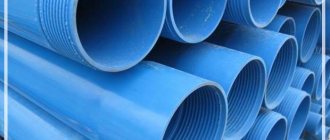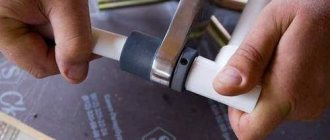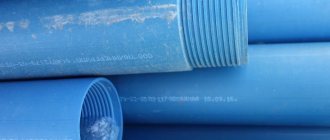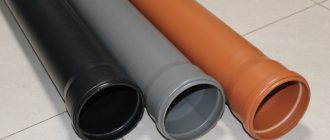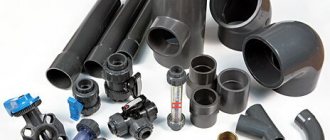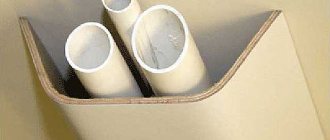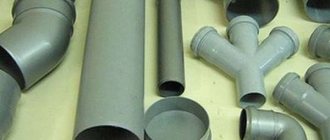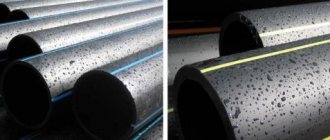Knowledge of how to seal a plastic sewer pipe when the necessary equipment is not at hand will be useful to every home craftsman. Often a leak that occurs needs to be repaired urgently when it is not possible to replace the damaged element. You can completely assemble a plastic pipeline system using special adhesives.
Sealing PVC pipes
Composition and principle of action of adhesive materials
Plastic products are glued together using specialized chemical compounds that dissolve the outer surface of the material. The active component in most variants is methyl ethyl ketone, cyclohexane or tetrahydrofuran. Glue for sewer pipes made of PVC or polypropylene is made from the same substance as the pipeline parts themselves. In addition, various additives are mixed into adhesive materials to influence the viscosity of the mixture and its setting time, as well as improve adhesion.
During the curing process of the glue, plastic pipes are rigidly connected due to the interweaving of molecular polymer chains on the outer surfaces of the parts being connected. The solvent evaporates and a compound is obtained that has the same characteristics as the new solid product.
Priority actions when a leak is detected
If a leak appears on a heating or high-pressure pipe, you must immediately shut off the system using shut-off valves. To solve the problem of how to seal a hole in a plastic pipe, you can use a clamp. Such structures are characterized by very simple use, which consists of putting them on the damaged area and tightening the bolts.
An older method is to use rubber: heating and water pipes are often repaired this way. This involves wrapping a piece of rubber around the damaged area, which can be done using an old car tire.
For clamping, use a clamp, thin wire or strong cord. Ordinary oil paint is also used, which is spread on a fabric pre-wound over the leak (read also: “How to fix a leak in a plastic pipe - options for sealing a leak”). All these methods have only a temporary effect, since the leak will definitely make itself felt later. The best option for repairing a crack in a plastic pipe is to completely replace the problem area, especially since in the case of plastic pipes this is not difficult to do.
How to choose glue?
When choosing how to glue a sewer pipe, you need to pay attention to the following factors:
- gluing material;
- setting time;
- technology of use;
- temperature conditions;
- time and storage conditions after opening the package.
All the necessary information is described in detail in the instructions, which should be read carefully.
There are 2 main groups of adhesive materials for gluing plastic pipes:
- One-component compositions. Such products are sold ready-made and do not require pre-mixing of the components. Adhesives are packaged in glass, plastic or metal containers and are used to join different types of plastic. They consist of dissolving, softening and joint-forming chemically active substances. But they do not have additives or additives that can change the duration of the chemical reaction and increase the strength of the joint. A typical example of such materials is sealant for polyvinyl chloride and polypropylene (Moment).
- Two-component compositions. They are produced in the form of 2 separate components, which are in different packages. Immediately before use they are mixed. Chemically more complex compounds, because they contain elements that improve adhesion and reduce the evaporation time of solvent components. The addition of additives helps accelerate the formation of stable polymer chains, resulting in stronger atomic-level bonds. Higher joint quality is ensured.
A convenient and effective way to quickly glue all types of pipelines is to use a special sealing tape.
Silicone material
Adhesive sealant for PVC pipes made of silicone rubber can be acidic or neutral. The first type is used on sewer pipes that are not susceptible to acid. The second is used for any materials, but is more expensive.
ADVICE! Silicone is a highly adhesive material, and is excellent not only for PVC pipes, but also for products made of cast iron and ceramics.
To apply the sealant glue, use a special syringe. The areas to be joined are thoroughly cleaned of debris beforehand; this is necessary to obtain the highest possible effect.
This glue may simply not stick to the uncleaned base of sewer pipes. After hardening, a waterproof and durable layer is obtained.
It will not allow any liquid to pass through the joint. These joints are known for their durability and long service life.
Other methods of sealing pipe joints
Video
Anaerobic adhesive sealant
Sealing pipe joints, in addition to the options described, can be done in other ways. It should be noted that they also cope well with the tasks assigned to them. Below we will talk about them in more detail:
- Melted bitumen. It is also known by another name – bitumen mastic. Actions with this sealant do not involve anything complicated.
- There are other sealants. For example: technical sulfur. The cost of this product is not high, and its distinguishing feature is its long service life. This type is mainly used for cast iron pipelines. Portland cement has almost the same characteristics. But, recently it has often been replaced with sulfur cement or sulfur concrete. These products can most often be found during the installation of sewer networks at large industrial facilities and in multi-storey buildings.
- A special type of sealant is epoxy resin. It is widely used not only for sewer outlets, but also in the construction of various structures where additional impregnation is required. In drain and water supply pipe networks, this type of material can be found where ceramic or cast iron pipes are located. Compared to PVC pipes, these products require more serious connections. And the advantages of epoxy resin include its resistance to chemical reagents and longevity. This product only resists sulfuric and nitric acid, acetone and hydrogen peroxide poorly.
- Previously, for finishing pipe lines in everyday life, jute was used, which was treated with resin. The action of jutes is a bit like self-adhesive tapes. But the principle of fastening in this case is slightly different. Jute is an ordinary twine, which, after being treated with resinous substances, becomes very durable. Finishing in this way is characterized by a long service life and high strength.
How to prepare and glue plastic pipeline elements?
Since pipe adhesive contains toxic volatile components, all work should be performed in a well-ventilated area. The temperature should be within +5…+35°С. It is recommended to protect your hands with rubber gloves to avoid causing an allergic reaction or irritation.
The sequence of actions is as follows:
- Cut pipe sections of the required length using special scissors (pipe cutter) or a fine-toothed saw. The edges of the cut are cleaned with a file and sandpaper to remove chips and burrs.
- Then the surface area to be glued must be thoroughly cleaned of dirt and thoroughly dried.
- Preliminary assembly of the pipeline structure and final adjustment of all elements are carried out.
- Before sealing the damage or gluing all parts together, the gluing areas must be degreased with a special solution or alcohol-containing liquid.
- The adhesive composition is thoroughly mixed. When using the repair method with two-component glue, measure out the required amount of material and knead it with your hands until it is ready (plasticine consistency).
- Using a brush or applicator, the glue is evenly distributed over the prepared surface. The parts are joined and fixed in a stationary state for several minutes (the exact time is indicated in the instructions). Sometimes re-application is required. Thick mastic is applied to the area to be repaired and pressed firmly with a tourniquet.
- Excess glue protruding along the edges of the joint is removed with a paper napkin or rag.
- The connected parts are left alone until the adhesive has completely dried.
The overall tightness of the connections and the reliability of the entire structure are checked no earlier than after 24 hours. When sealing a leak, the repair compound hardens within an hour.
Criterias of choice
When choosing what to seal a plastic sewer pipe with, you need to consider several factors:
- pipeline material;
- installation and operating conditions;
- what loads will the connecting elements experience (gravity or pressure sewerage).
There are many compounds on sale designed for gluing plastic pipes. They differ in price, amount of material in the package, and purpose. Popular compositions are called “cold welding”. They are able to work not only with gravity lines, but also with pressure lines. It is recommended to buy only products from well-known brands. The most reliable are European manufacturers. Their adhesive compositions undergo thorough quality control, they are certified and meet all technical requirements. Buying compounds from Southeast Asian countries is risky. It is very likely that after using them you will have to think again about how to seal the sewer pipe. You should not take risks in this matter, since leaks can cause great trouble for neighbors on the lower floors. Saving on quality means doing all the work twice, plus restoring the finishing of the neighbors below. Sewerage assembly is done once every many years, so it is advisable to spend a little money.
Also read: Drain from the sink into the sewer: drainage unit, installation procedure, review
Causes of defects when gluing PVC pipes
Sometimes, some time after sealing a crack in a PVC pipe or gluing the entire structure together, liquid leakage is observed at the joints. Most often, the reasons are the following technological violations that were committed during the work:
- Poor surface preparation on the old pipe and the presence of severe unevenness. If the edges of the cut are processed poorly, when roughness remains on the material, the adhesive composition unevenly dissolves and softens the material.
- Contaminants remain in the treated areas. Non-greased surfaces also cannot be well saturated with glue.
- Uneven application of the adhesive composition leads to non-adhesiveness in certain joint areas.
- The seam is not completely glued if a thin surface film has formed on the glue layer due to its overdrying. All work must be carried out quickly.
- A soft and loose adhesive layer, instead of a good strong seam, is formed at low ambient temperatures during work. In this case, the solvent does not evaporate completely and the composition does not harden.
- A porous adhesive layer may remain if the components were not mixed well before application. Remaining air bubbles greatly weaken the seam.
- Insufficient compression force or insufficient holding time, resulting in distortion and displacement of the parts being bonded during curing of the composition.
- Wrong brand of glue chosen.
To avoid having to take additional measures to eliminate leaks due to poor-quality gluing, it is necessary to correctly select the adhesive composition and strictly follow the work technology.
How and how to repair a hole in a plastic pipe - methods tested by experts
Modern household communications are increasingly equipped with plastic pipes: this is especially true for sewer and water supply systems, most of which consist of polypropylene or PVC products. Like any other plumbing, these systems require periodic repairs.
Priority actions when a leak is detected
If a leak appears on a heating or high-pressure pipe, you must immediately shut off the system using shut-off valves. To solve the problem of how to seal a hole in a plastic pipe, you can use a clamp. Such structures are characterized by very simple use, which consists of putting them on the damaged area and tightening the bolts.
An older method is to use rubber: heating and water pipes are often repaired this way. This involves wrapping a piece of rubber around the damaged area, which can be done using an old car tire.
For clamping, use a clamp, thin wire or strong cord. Ordinary oil paint is also used, which is spread on a fabric pre-wound over the leak (read also: “How to fix a leak in a plastic pipe - options for sealing a leak”). All these methods have only a temporary effect, since the leak will definitely make itself felt later. The best option for repairing a crack in a plastic pipe is to completely replace the problem area, especially since in the case of plastic pipes this is not difficult to do.
Using sealant and epoxy glue for plastic pipe
A number of factors can contribute to the appearance of cracks or leaks in a plastic pipeline. These are both mistakes made at the installation stage of the system and violation of operation. And the plastic parts themselves may be defective.
If the size of the resulting crack is small, then it is not necessary to replace the entire pipe. You can try sealing it with silicone sealant first, especially if we are talking about permanent damage. Most often, sewer systems are repaired in this way.
In this case, you need to act like this:
- Clear and expand the damage. This is done to ensure deeper penetration of the sealant.
- Degrease and dry the repaired area.
- Apply the required layer of sealant and let it dry thoroughly.
However, it happens that the pipe receives through damage. How to seal a sewer plastic pipe in this case?
This is done using a two-component epoxy composition, following the following sequence of work:
- The area where the damage occurred must be cleaned, degreased and dried.
- To prepare the bandage you will need fiberglass or other dense and flexible material.
- The prepared bandage is used to wrap the crack itself and the area around it, with a good margin. You need to wrap the material around the pipe at least 5 times.
- At the final stage, epoxy glue is applied.
In addition to sewer systems, water pipes and heated towel rails can be repaired in this way.
How to Seal a Hole with Sealing Tape
Using this modern material, you can efficiently eliminate small leaks in pipes located in bathrooms. Externally, it is an adhesive fabric impregnated with special substances. Most often, joints and connecting elements are sealed with sealing tape. As for straight sections, they can also be repaired using this method.
When using sealing tape, it is important to follow the following sequence of work:
- The damaged area must be thoroughly cleaned and dried.
- After stretching a small piece of tape, it is wrapped around the pipe. It is important that this procedure is accompanied by constant tension in the tape, otherwise folds will appear.
- When winding, each new turn should be laid on half of the previous one. It is best to pack the pipe with two layers of sealing tape.
The main disadvantage of this method is the insufficient resistance of the repair material to sunlight. To achieve a good service life, the wound tape is coated with additional protection.
Cold Welding Crack Repair
Currently, specialized cold welding for sewer pipes is offered in specialized stores. It is manufactured specifically for the repair of plastic products used in the organization of water supply systems, cooling systems, and heating communications.
Using cold welding, damage of almost any degree of complexity can be repaired. There is no need for thermal exposure, since a chemical reaction is used to bring the components into working condition.
The work itself to repair a damaged plastic pipe has the following sequence:
- It all starts with surface preparation, for which the entire problem area is treated with emery cloth. This is followed by degreasing the base using alcohol-containing liquids. If you neglect this procedure, the applied patch will serve much less.
- You need to calculate exactly how much material is needed for a high-quality seal. For this, a simple visual inspection is usually enough: the main thing here is that the repair mixture can cover the entire problem area.
- You need to take the substance into your hands, which you have previously put on protective rubber gloves, and begin to knead. This procedure is continued until the material is painted a specific brown shade. Another sign that the material is ready is when the mass reaches the state of plasticine.
- You need to seal the damage well with the finished plastic material, pressing it with a tourniquet. Next, there is a pause in work for about an hour: during this time, the repair mixture hardens. It must be made so strong and dense that any drilling, cutting and other impacts on its surface are completely safe.
It is important to take into account the presence of components harmful to the human body in cold welding. For safety reasons, it is recommended to acquire protective gloves and goggles in advance. To speed up the hardening process of the plastic mass, some experts recommend exposing it to warm air, using a construction or regular hair dryer.
Cold welding for sewer pipes is suitable for repairing damaged plumbing fixtures. For example, if a piece of material breaks off from a sink or toilet, cold welding will help to properly glue it back. When purchasing this universal product, you should check its expiration date, composition features and availability of a quality certificate.
Source: https://trubaspec.com/montazh-i-remont/chem-i-kak-zadelat-dyrku-v-plastikovoy-trube-proverennye-masterami-sposoby.html
What to do first when a leak appears
If there is a leak in high-pressure pipes, a heating system or other communications in an apartment or house, then first of all you need to shut off the shut-off valves. This truth is familiar to everyone. But what to do next?
It is possible to “plug” a leak that appears using clamps. Such structures are placed on the required area and tightened with bolts.
It is possible to use the old method - use rubber. I quite often repair heating or water pipes using this method. The problem area is wrapped with a piece of rubber (for example, from car tires) and clamped with a clamp or tied with a narrow wire or strong cord.
Advice! It is possible to use simple paint. The place where a crack or leak appears is wrapped in cloth and painted over with oil paint.
But all the methods listed above can be considered a temporary solution. If such patches are left for a long time, the leak will appear again. It is on this basis that many craftsmen advise replacing the problem area, especially since it is quite easy to do this using plastic pipes.
The first signs of a pipeline leak
In most cases, leaks in utility lines are immediately noticeable. After all, puddles appear on the floor and other structural elements of the building. However, minor leaks are not always so obvious.
Heating pipe is leaking
If the leak is small, it can be determined by the following signs:
- PP pipes become wet;
- drops that look like dew appear in the area of the fittings;
- the pressure in the pipeline system drops sharply.
If any of the above situations occurs, the owner of an apartment or house needs to pay attention to the water supply network. Perhaps it's time for a renovation.
A leak that is not eliminated, even in the form of a small trickle of water, will cause irreparable harm. Moisture can get on electrical appliances, penetrate electrical cables, or ruin just-completed renovations for neighbors on lower floors.
Step-by-step instructions for using the composition
Work should be carried out at temperatures from +5 to + 30 degrees, good ventilation should be ensured. The following steps are performed:
- First, the pipeline must be cleaned of all types of contaminants and also degreased;
- They make markings, indicate the places where the coupling will take place, it is better to draw a diagram in advance;
- The pipes are cut to the required sizes;
- You can use a glue gun or a brush to apply glue. The solution should be applied evenly to the surface; there should be no empty areas;
- Having connected the parts, hold them for half a minute so that setting occurs, it is advisable to leave them for 24 hours;
- If excess glue comes out, wipe it off immediately;
- After 24 hours, the fixation is checked to see if there are any leaks left.
Work should be carried out at temperatures from +5 to + 30 degrees, good ventilation should be ensured.
Rules for working with adhesives
To cut the material, it is better to use a pipe cutter; it will ensure smooth cutting. It is better to also treat the surface with sandpaper to improve adhesion.
It is recommended to try on the materials first to ensure correct cutting.
To cut the material, it is better to use a pipe cutter; it will ensure smooth cutting.
Emergency repair without draining coolant
Possible if the water does not stream, but simply drips.
1. Crimp with a screw clamp without using glue. Let's take advantage of some of the elasticity of polypropylene. A crimp clamp is applied to the coupling from which it is leaking. After tightening the screw, the leak will decrease and possibly disappear altogether. You can leave it like this until the end of the heating season. But when the temperature of the coolant changes, polypropylene contracts and expands. You will have to constantly monitor the joint.
Therefore, it would be more correct to additionally seal the connection using an adhesive.
2. Application of “cold welding”. Most of these compounds can be used in damp environments.
The main thing is that the binding force of the glue can withstand the pressure of flowing water. This is where preventive crimping of the coupling using a clamp will help. Simply covering up the leak is not enough. After several temperature changes, micro gaps will appear between the glue and the pipe, and the flow will resume. For reliability, it is necessary to install another supporting coupling opposite the defective joint, let’s call it a repair coupling. It is cut from standard connecting fittings. To put it on the pipe, we make a longitudinal cut (cut).
We clean the pipe with sandpaper, degrease it, and dry the leak area if possible.
We put a repair coupling on the pipe, prepare “cold welding” glue, and cover the leak area. We move the coupling to the joint, fix it with a second clamp.
In this case, the glue will compact between the couplings and fix the leak. Due to the mixing of “cold welding” with water, the appearance is not very aesthetic. This does not affect the strength (the glue is designed for such use).
The goal has been achieved: the leak has been eliminated. But this solution is temporary; the epoxy glue will gradually crack.
How to repair small damage
Sometimes the cracks are so small that they are almost invisible. They can only be detected by smell. Most often they appear from mechanical impact - a blow from a heavy object or the fall of something sharp.
Minor damage is difficult to detect. You need to carefully examine the pipe, perhaps even with a magnifying glass. There may be several chips. Even the smallest of them cannot be ignored. If the crack is not sealed, it will deteriorate further and may crack so much that it needs to be completely replaced.
When all points of damage have been identified, repairs begin. To restore small chips, it is enough to apply hot glue to the plastic. To get a positive effect, it is important to do the work correctly:
- Before starting repairs, dry the damaged areas with a hairdryer.
- Clean the crack with fine-grain sandpaper.
- Degrease the surface.
- Warm up the heat gun to the desired temperature. It should not be excessive, otherwise the pipe may melt. It is selected individually, depending on the material from which the pipe is made. Usually, after installing a drainage system, cuttings remain. Preliminary testing can be done on them.
- Applying hot glue to the crack. If it is horizontal, the direction in which the nose of the gun moves does not matter. Most often it is carried out from left to right. When the crack is vertical, the nose of the device must be directed from bottom to top, as during welding work.
- Cracks on the pipe and at the joint are almost invisible. They can be identified by their smell and hanging drop.
- The glue is applied 2 cm further from the beginning of the crack on each side. If it spreads wide, it can be corrected with a spatula and pressed onto the surface.
Hot-melt adhesive dries very quickly, literally in a few minutes. You don't have to wait long to start using the sewer again.
Using Cold Welding
An effective way to reliably seal a leak is to use cold welding to repair plastic pipes. This is a special repair compound that needs to be applied to the problem area. The material is sold in specialized stores.
The pipe surface to be repaired is first cleaned with sandpaper, thoroughly degreased and dried. After this, you need to take a sufficient amount of cold welding and knead it thoroughly. In this case, your hands should be wearing moistened rubber gloves. The material is kneaded until it changes color to brown and acquires the consistency of plasticine. The prepared mass must be applied to the area to be repaired and pressed tightly with a tourniquet, leaving it there for an hour. During this time, the cold weld will harden and form an almost monolithic connection with the plastic.
RESULTS ºÑƒ в пР»Ð°Ñ тиковой трубе
